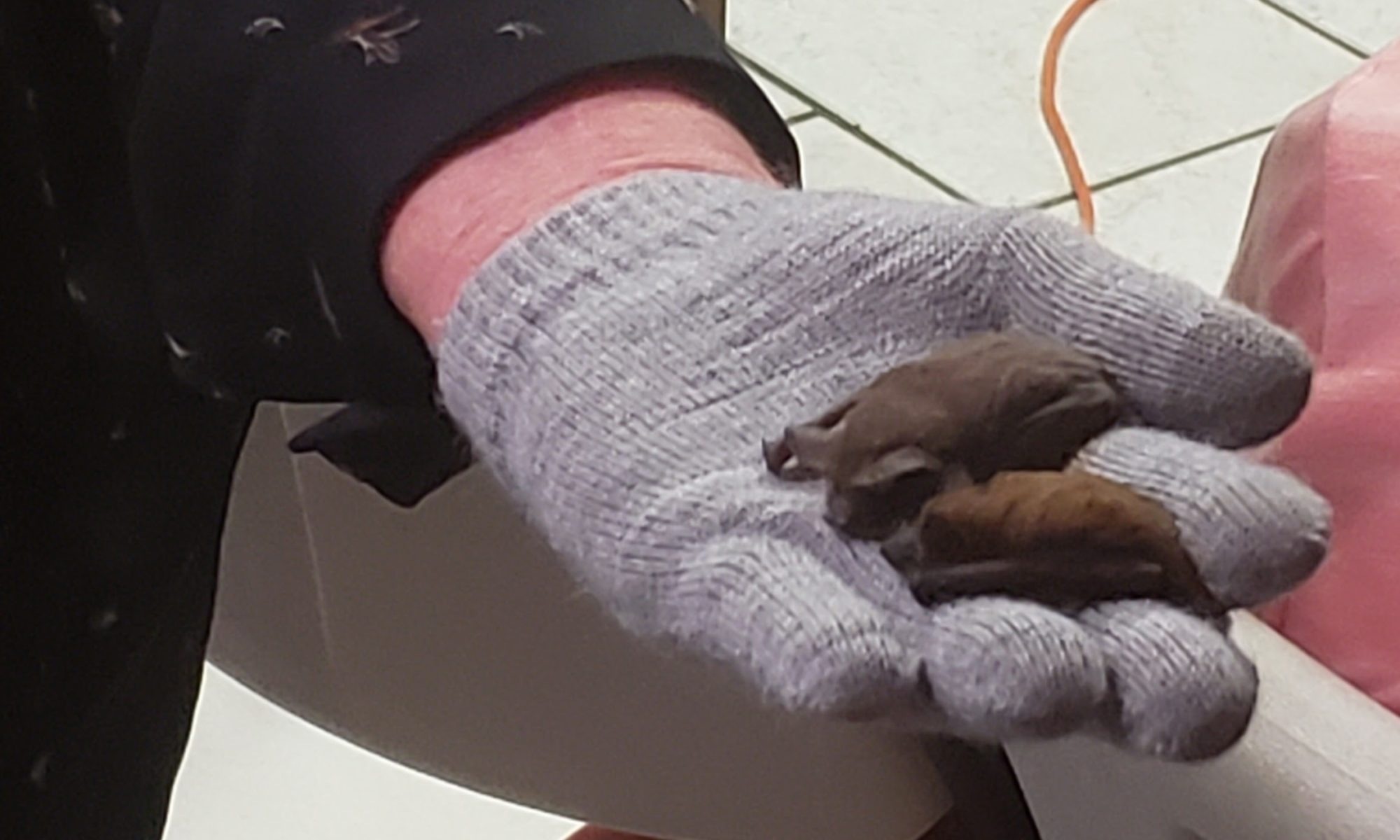I really like bats, but what I know about them could fit in a thimble. A really tiny thimble. So, they eat insects, fly at night, and don’t really get tangled in our hair. . .that’s about what I knew before Steve and I listened to Sherry from the Florida Bat Conservancy share her knowledge and passion for bats. We were also able to see two bats up close, and then watch a bat colony take flight at dusk. Now I want to know more, and Steve has finally agreed that we should have a bat house or two on our property.
Probably the most fascinating fact Sherry presented is that bats are primates, and their closest evolutionary relative is probably the lemur. As mammals and primates, they breastfeed their young — IN FLIGHT. In researching this, I’ve learned that bats are unusual in that such small animals generally give birth to litters of young, but bats normally have only one baby, called a pup. These pups can take up to seven months to develop, and may weigh up to a third of the mother’s body weight. When the pup is born, mom is hanging upside-down, and must catch the pup in her wings when it is delivered or it would fall to the ground. Motherhood is tough!
Sherry also shared with us some interesting facts about vampire bats. Florida has no vampire bats, which live in southern Mexico, and Central and South America. I had always assumed that they sucked the blood of mammals, but this is not true. Vampire bats feed from birds! Before feeding, the bat spends several minutes licking the skin of the bird, because the bat’s saliva contains substances that make it possible for feeding to occur. First, surfactants soften the skin, making it easier for the bat to create a small cut with the side of an incisor. Next, an anesthetic allows the bird to remain comfortable enough that it does not wake up during the bat’s feeding. Finally, enzymes in vampire bat saliva act as anticoagulants, which keep the blood flowing while the bat licks up about a teaspoonful. There is no violent blood-sucking — just a gentle licking upof droplets of blood. In the morning, the bird wakes up and flies off, completely unaware of what has happened while it slept.
A side note here: those anticoagulants in the bat’s saliva? Research on those chemical compounds helped create new drugs used to bust clots in stroke patients and avoid clots in cardiac patients. Eliquis, which Steve takes to avoid stroke due to atrial fibrillation, shows a greater reduction in stroke risk, less risk of major bleeding, and reduced overall mortality when compared to warfarin, the previous treatment. He is also able to avoid additional lab work that would be required with warfarin treatment. So I’m very grateful to vampire bats and their sophisticated saliva. The Florida Bat Conservancy says that over 80 life-saving medications arise from bats, along with hundreds of other commercial products.
Another fun fact — while bats do not really get tangled up in our hair, they may sometimes fly very close to our heads, and there’s a good reason for that. When we cover ourselves in fragranced products like soap, antiperspirant, hair spray, aftershave, or perfume, insects are often attracted to those scents. And guess who is attracted to those insects? Bats! They’re not trying to nest on our heads, they’re just trying to catch their dinner.

The two blurry objects in the top right of the photo above are bats, flying at up to 65 miles per hour. My phone camera, as terrific as it is, was just not up to the challenge. The bats in the colony we visited are mostly Brazilian Free Tail bats, and each will eat thousands of insects in a single evening of feeding. Florida has 13 species of bats, all of which are insectivores. Just as humans like to visit Florida, so do some bats that don’t normally live here. These are usually from tropical areas and feed on nectar and pollen. On the rare occasions that they have been found in Florida, they have been in South Florida and the Florida Keys.
Some bats live solitary lives, but others form colonies. Bats that live in colonies like to be very close together and are affectionate with one another. Colonies can contain thousands of individual bats. Bats have incredibly long lifespans – averaging 25-40 years. In spite of this, bat populations are threatened around the world. While they live a long time, they experience high infant mortality and reproduce slowly. Their habitats, like those of other animals, are dwindling. White nose virus threatens cave- and mine-dwelling bats. Pesticide use not only kills the insects most bats depend upon for their food supply, but can directly sicken bats as well.
If you’d like to learn more, there is no shortage of bat-related resources. Here are a few for you to visit:
Florida Bat Conservancy: this organization provides conservation information, education, and advocacy.
Bat Belfrys, Inc: this organization provides education and builds bat houses. You can reach them at batsbelfrys@gmail.com.
Organization for Bat Conservation: Provides information, education and advocacy.
The bat house at Fort Cooper was built as an Eagle Scout project. Other large bat houses are located at University of Florida in Gainesville. It may take years for bat houses to become occupied, and some never are. One of our favorite places to visit in the Keys was the Perkey Bat Tower on Sugarloaf Key. This interesting structure was occupied by transplanted bats for a short time, but they flew off and never returned. Unfortunately, the Perkey Bat Tower was destroyed by Hurricane Dorian. We will build and install a bat house or two, but they will be much smaller! We hope the bats will come quickly and feast on mosquitoes.

